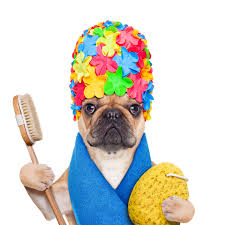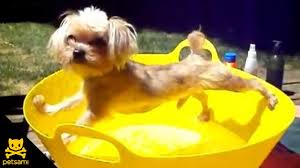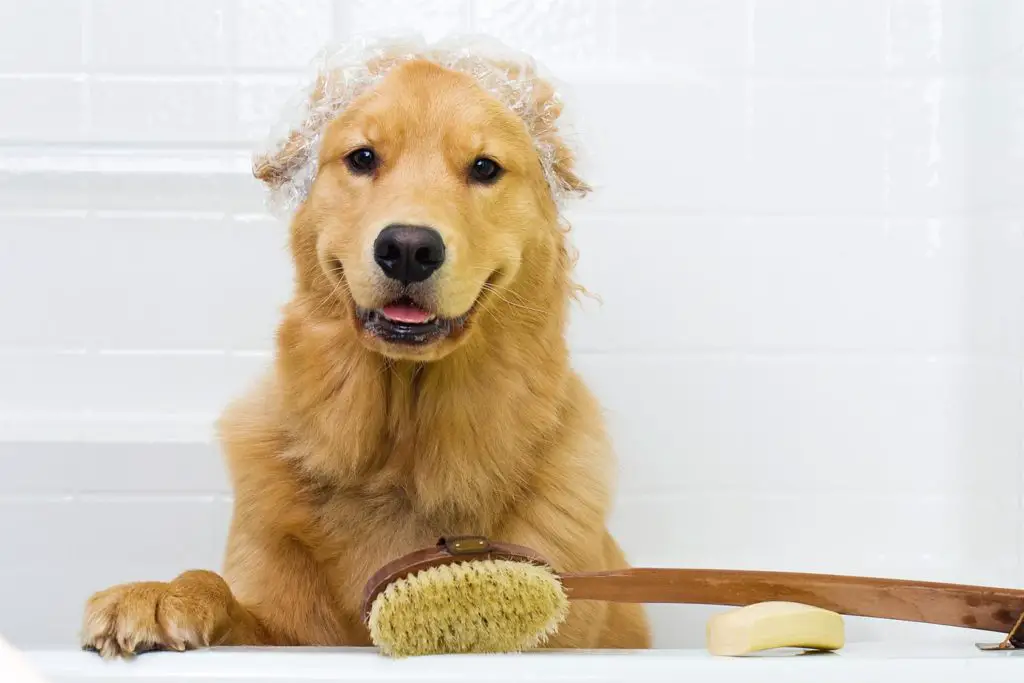Table of Contents
How to bathe a dog at home
The easiest way to bathe your dog at home is by using a hand-held shower head, but if you don’t have access to this set up you can do it by scooping water over your dog with a bowl. Just be sure to rinse fully.
Dog bath water temperature
The water should be lukewarm or tepid as the natural body temperature of dogs is higher than humans so you don’t need it as warm as you do with your own shower.
Steps to bathe your dog
Step 1
Brush your dog before the bath to remove any tangles or knots. Matted fur holds water which will tighten the knot when it drys.
Step 2
Start by thoroughly soaking your dog’s coat being careful not to get water in the ears. It is a good idea to put cotton balls in the ears before you start to avoid this.
Step 3
To wet your dog’s head use your thumb to flatten down the ear and from back to front wet that side of the head. Repeat on the other side. Gently hold your dog’s head down by the muzzle and wet face. Now raise the head up and wet under the chin being careful not to get water in the nose.
Step 4
Use tearless baby shampoo to thoroughly wash your dog’s face. Then apply the other regular dog shampoo down the dog back and work into a lather using your fingers or a rubber dog bathing brush such as The Zoom Groom.
Step 5
Many shampoos are quite concentrated so you can premix with water which will help the shampoo lather and will rinse better. Work in the direction the coat lays or the coat will be trained to stand up. Never use human shampoo on your dog as human hair has a different pH level and it will dry and irritate your dog’s skin. Human shampoos may also contain chemicals that may cause a skin irritation.
Step 6
Then rinse your dog using the same process you use to wet them. I always do two lots of shampoo as it gets the dog much cleaner and the clean smell lasts longer, so with the first rinse, you don’t have to rinse as thoroughly as you will with the final rinse.
Step 7
Once you have done the two shampoos and thoroughly rinsed all the shampoo out of the coat scoop excess water off your dog with your hand. If you don’t want your dog to shake while in the bath put a towel over them and pat to dry.
Step 8
Then dry as best as you can by rubbing with a towel working in the direction of the coat as much as possible. You can even leave them wrapped in a towel for a while to absorb as much water as possible. Don’t forget to remove the cotton balls from their ears.
How to dry your dog.
Get your dog as dry as possible using a towel, micro cloth or chamois. You can wrap the towel around your dog and hold in place with clothes pegs or bulldog clips and it will absorb a large quantity of the water in the coat
Obviously, you can’t clip or groom your dog until they are fully dry. Clipping a dog that is still damp will clog the blade and it will leave clipper marks on the coat resulting in a bad finish.
is still damp will clog the blade and it will leave clipper marks on the coat resulting in a bad finish.
The solution is to either wait until they are dry, perhaps the next day or to blow dry. Using a hand-held dryer for human hair is fine for a small fine haired breed such as a Yorkshire terrier. For a dog with a thicker or longer coat, this would take an awfully long time.
The best solution is to use a dog blow dryer. Commercial dog blow dryers like those used in grooming salons are very expensive, however, there are available smaller dog dryers available at very reasonable prices.
I would recommend something such as these low-cost dryers which come with two airspeed settings and three heat levels (no heat, medium and high) and several easy to attachments to increase air flow.
I have blow dried long coat large breed dogs with this type of dryer and it was more than up for the job. Although small dryers like this don’t have the air velocity of large commercial grooming dryers by using the heater the coat still drys quickly.
It also helps to straighten the coat making it better for clipping and scissoring. Just be sure not to allow the air to get too hot and keep the air moving.
How often should you bath your dog?
It depends on the reason for the bath such as do they smell or are they covered in dirt or whether they need to be bathed in a medicated shampoo provided by your vet for skin issues.
If your dog comes into a room and you can smell them they probably need a bath or if they are covered in mud and dirt they probably need a bath. A general guideline is monthly but it does depend on the type of coat and breed.
Some breeds and coat types smell more than others. Dogs with oily coats may need bathing more often while other dogs may need less frequent baths to retain the natural oils in their coats.
Dogs with thick double coats such as Samoyeds, malamutes, and huskies require bathing less often as they tend not to smell that much but may require more brushing to remove dead undercoat and distribute the natural oil around the coat.
Some shampoos may strip the natural oils from your dog’s coat so if bathing more frequently than monthly use a gentle or soap free shampoo.
The best test to see if your dog needs a bath is to give them a good sniff. If they don’t smell good it is probably time for a bath.
What is the best shampoo to use for my dog?
Go to your local pet store and you will see an overwhelming range of shampoos available for your dog. Just remember never use human shampoo as they may contain harsh chemicals they may be harmful to your dog.
Some of the factors to consider when choosing a shampoo for your dog are:
Skin condition: If your dog has dry, itchy or sensitive skin a moisturizing shampoo is a good option. Avoid scented shampoo which may contain chemicals that can irritate the skin. Instead look for shampoos that have natural ingredients such as oatmeal, vitamin E or aloe or are soap free. If your dog has skin allergies your vet may recommend a medicated shampoo to treat the condition.
If your dog has fleas or ticks there are shampoos to treat for this. These only offer a short-term solution so it is important to use them to supplement other flea and tick prevention products.
If your dog is a puppy there are many gentle and natural puppy shampoos available designed to specifically for puppy coats.
For really smelly dogs there is deodorizing shampoo to help eliminate odors rather than simply covering them up.
For coats that tangle easily there are shampoos which are shampoo conditioners or you can use a separate conditioner after shampooing your dog.
Once you have taken these things into consideration choose a shampoo your like the smell off. Check the label and try to avoid artificial ingredients and opt for more natural products like oatmeal and aloe vera.
How to bathe a dog outside
Bathing a dog outside means less mess inside. It may also be the case that you don’t have the facilities inside to bath your dog.
This may mean you will have to use the hose which will be cold water. This is best suited for the summer months.
Alternatively, you can fill some buckets with warm water. Use a container to scoop the water over your dog. Or stand your dog in a baby bath and fill with water. Have some buckets of fresh water handy to rinse your dog.
Follow the procedure above for bathing your dog. Be extra sure to rinse all the shampoo from their coat.
When finished, stand back to allow them to shake off the majority of the water. Move to a dry area some you are not kneeling in dirty water. Cover them with a clean, dry towel. Massage and “pull” the water from the coat.
Use a Waterless Shampoo
A further option to clean your dog is a waterless shampoo. Work the waterless shampoo into your dog’s coat. Using a towel or sponge, wipe the shampoo and dirt from the coat.
A waterless shampoo is a good way to give your dog a clean when you are unable to give them a full bath. However, waterless shampoos cannot replace bathing completely.
How to bathe a dog with fleas
Giving your dog a flea wash is a good start to a flea control program. If your dog has fleas and you apply a flea application it will not be as effective.
Therefore it pays to eliminate any live fleas on your dog with a flea bath first. The easiest way to do this is to use a good quality flea shampoo.
Follow the bathing procedure above but use a flea shampoo instead.
Using vinegar to kill fleas
A popular alternative to kill fleas is to use white vinegar. You can apply the vinegar in several ways –
- shampoo your dog and lather. Pour the vinegar into the lathered shampoo and work it into the coat.
- bath your dog. While still wet pour the vinegar over or use a spray bottle to apply
Be sure not to apply the vinegar around the face area to avoid contact with the eyes. Don’t worry, the vinegar smell fades quickly.
12 Common Dog Bathing Mistakes
Some dogs enjoy having a bath but for the vast majority bath time is a little stressful and for some, it is something to be avoided at all costs. To make giving your dog a bath easier and less stressful it is best to avoid these common mistakes.
Not getting organized first
Have everything you are going to need organized and within reach before you start. There is nothing worse than having a soaking wet dog in the bath and you can’t reach a dry towel. It is guaranteed that you and the room are going to get wet.
Not brushing first
It is important to give your dog a brush before you bath them. Any knots or tangles will  absorb the water and tighten making it much higher to remove them once the dog is dry.
absorb the water and tighten making it much higher to remove them once the dog is dry.
With a double coated dog remove as much of the dead undercoat as it will take a lot longer for them to dry. It will also leave a lot of fur in the bath making for more mess to clean up and may also cause matting.
Avoid brushing your dog when they are wet as this is more likely to cause brush burn and damage to the skin. Once they are fully dry after the bath give them another brush to ensure there are no tangles. This will help to remove any remaining dead undercoat.
Bathing too often or not enough
How often you bath your dog will depend upon a number of factors. Such as how dirty or smelly they get and the type of coat. Bathing too often can strip the natural oil from their coat causing dry and sensitive skin.
If you are bathing more often than every three or four weeks I would recommend using a shampoo that is formulated for frequent bathing such as a natural or soap free shampoo. Not bathing often enough results in your dog not getting used to the whole process and probably not meeting their grooming requirements are probably not being met.
Bathing your dog while over excited or energized.
Give your dog a walk and some exercise with a period of relaxation before the bath to ensure they are calm and not over-excited. While doing the bathing talk to them in a calm relaxed manner to give them reassurance. Talking to your dog in a high-pitched excited manner will reinforce and give energy to an already excited or anxious state.
Using a human shampoo or conditioner.
You should never use your own shampoo on your dog as dog fur has a different pH level than human hair and the harsh chemicals in a lot of human shampoo can irritate the skin. Select a shampoo that is suitable for your dog’s needs.
Wrong water temperature
The natural body temperature of a dog is higher than that of a human so you don’t want to have the water as hot as you would for your own shower. The ideal temperature is lukewarm around room temperature.
If the water is too hot or even too cold it will create a negative experience for your dog. This will make bath time even less fun for them than is probably already is. Test the water temperature on your forearm first to test it as this area of your skin is more sensitive to temperature than your hands.
Harsh water pressure
When using a hand-held shower head to bathe your dog, which is probably the easiest way the sound and spray of water can frighten and unsettle your dog.
If you shower has an adjustment to decrease or increase the water flow set it at a level that is sufficient to wet the coat but not so full on that water is hitting your dog and spraying everywhere. If you don’t have this adjustment compatibility with your shower you can use allow the water to hit your opposite hand before hitting the dog.
Getting shampoo in your dog’s ears, eyes or nose.
Having their face and head wet is often the most unpleasant part of bathing for your dog. Some people avoid washing the head altogether. It is important that this area is cleaned as it often is the smelliest part of a dog.
dog. Some people avoid washing the head altogether. It is important that this area is cleaned as it often is the smelliest part of a dog.
We often pat them around the head with odors and oils from our own skin transferring to them along with food and water making the mouth and chin area smell.
It is important to not get shampoo in the eyes as this can sting causing irritation and harm to the eye and even something called dry eye. To avoid this I use a tearless shampoo or baby shampoo which allows me to give the face a good clean without this being a problem.
To avoid getting water in the ears you can put cotton balls in the ears before the bath. Just remember to remove them after the bath. Ensure that you cover the ear up fully before running water over the head by using your thumb to lay the ear flat with the head directed downwards and wetting just that side of the head.
When rinsing under the chin hold your dog’s muzzle up and carefully wash shampoo from this area to avoid water going in the nose.
Wetting the head first.
The best place to start wetting your dog is at the rear to avoid giving them a fright and work your way up the body to the back of the head. Many dogs will try to shake once their head is wet. If your dog is prone to shake water everywhere perhaps leave wetting and washing the head until the end.
Poor soap application
It is important to distribute the shampoo even and all through your dog coat including giving the paws and rear a good clean. Many shampoos are highly concentrated so it often a good idea to mix in a separate bottle with water with a mix of around 10 to 20 parts water to 1 part shampoo dependant on the individual shampoo.
Work the shampoo into the coat by going with the lay or direction of the coat. Repeatable going against the coat may cause the coat to stand up or lay backward when dry and can even cause ingrown hairs. Actively work the shampoo into the coat all over for a couple of minutes or more. Then thoroughly rinse all the shampoo out
Not rinsing properly
Ensure that you make sure to fully rinse all the shampoo out. If not fully rinsed you will often see a residual on the coat and it may irritate your dog’s skin. If your dog gets wet again it will reactivate the shampoo and start to lather.
Harsh drying technique
A lot of dog owners quickly towel down their dog but it is important to get the coat as dry as you can. Use the towel to gently squeeze the fur and pull out as much of the water as you can. Your dog should be damp but not dripping wet.
If you are going to blow dry your dog, ensure that the air temperature is not too hot. Check by having your opposite hand there so you can feel the heat. Start at the lower back of your dog so as not to frighten them when the dryer starts. Work your way around drying each area to near dry before moving to the next. This is more efficient than randomly moving the dryer all around. Once all areas are mostly dry go over the dog again just to ensure that all dampness is gone.
Related Posts
